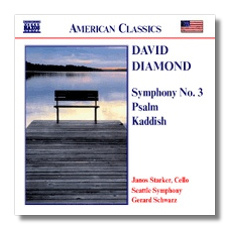
The Internet's Premier Classical Music Source
Related Links
- Latest Reviews
- More Reviews
-
By Composer
-
Collections
DVD & Blu-ray
Books
Concert Reviews
Articles/Interviews
Software
Audio
Search Amazon
Recommended Links
Site News
 CD Review
CD Review
American Classics

David Diamond
- Psalm (1936)
- Kaddish for Cello and Orchestra (1987) *
- Symphony #3 (1945)
* János Starker, cello
Seattle Symphony Orchestra/Gerard Schwarz
Naxos 8.559155
The Seattle Symphony has jumped the Delos ship and signed up with Naxos. Since this release is an exact duplicate of a Delos issue, I was certain another of my esteemed colleagues had reviewed it. But, no, I was surprised mainly because this is such good music.
Some critics have maintained that words cannot really tell us about music. If you attempt to talk about what the music is about this is probably true. For example, you might describe this symphony thusly; "it consolidates a cyclic form by amalgamating all of the thematic material [presented] throughout. Apart from [the] principal… materials and their development in all [four] movements, two 'motival' themes [connect] the entire symphony cyclically, appearing [either] completely or in fragments a (a), or A (b) or combined with B." That was from the composer's own notes for the Boston Symphony première. This technical prose tells us nothing about the feelings in the music and if music doesn't convey feelings it conveys nothing at all. Poetry, on the other hand, expresses feelings no less than music and it is to the words of feeling that a writer must turn in order to try to convey how the music is working. For example:
The third symphony opens with a feeling of nervous energy from the strings. Brass and timpani emerge from this, but not in anger rather with a sense of triumph. The strings return but this time there is an aura of serenity and peace, bringing to my mind houses in the country with swings on the porch. Brass and timpani, along with the piano, play the prominent role in the movement with the overall feeling, as already stated, of triumph but a triumph of the soul. It was after writing this description that I read that the work was composed in 1945 and I wonder if the approaching end, or end of the war might have provided some of the feelings in this movement.
The second movement is marked andante. The strings steal in tenderly. The piano emerges and then is joined by the harp as they sing together. The whole thing is more an adagio than andante not unlike a choir in a church with solos from woodwinds and trumpet in the distance. At 7:40 the brass emerge in a Bachian chorale and then subside like the tide. It is all really an elegy, one of the most haunting things I have heard.
The snare drum erupts, introducing the third movement. Strings and brass answer energetically. Still, these are threads rather than a dialogue until the piano plays an infectious melody around which the music weaves a joyous romp. I'd swear I've heard that piano melody somewhere else but can't put my finger on it.
The fourth movement is another slow one. It is marked adagio assai. I find it tender, like a love song between the clarinet and oboe in it.
As I try to pull the whole thing together I am amazed that the composer was only 30 when he wrote it. I am also fascinated by the fact that, given the time it was written, it such an optimistic work. It is a young person's symphony and I am going to seek out more music by this composer.
When you read this kind of description, talking about the feelings rather than the form, you have a kind of map for what you might experience the first time you hear this music. These are not just subjective reactions to the music. I have found that there tends to be a degree of consensus when people listen to music. While you may disagree to some extent with what I have written you will at least have been given a feeling to take you along the journey and I believe we will arrive at a similar destination.
My thoughts about the other works on this disc are similar. Psalm was another early work, composed when he was just 21. Apparently it refers to no specific psalm and was written after visiting the graves of Oscar Wilde and Sarah Bernhardt. I don't know what that has to do with the music but Steven Lowe mentions it in the notes. Conductors such as Monteux and Leopold Stokowski championed it. The Kaddish was written for Yo-Yo Ma in 1987. As it happens it was the result of a suggestion by this conductor. For what are probably obvious reasons it brings to mind the movie Exodus. Like the symphony this music is "accessible" in a good way. That is, it is memorable without being banal.
The sound in this recording is spectacular. It brings out the inner details, the solo voices of woodwinds and piano. The timpani literally moves you.
When I listen to a composer who is new to me I attempt to get a hold on what I am hearing by seeking patterns similar to other composers of the time and place. In this case I listened to hear if I detected Copland since they were contemporaries. Well, no dice. Diamond has his own unique musical voice.
If "new music" scares you then turn to this. It is romantic, not dissonant or cerebral (even though the composer's comments seem so). This is not just "good for the price" but that certainly should help those reticent to explore.
Copyright © 2001, Robert Stumpf II


















